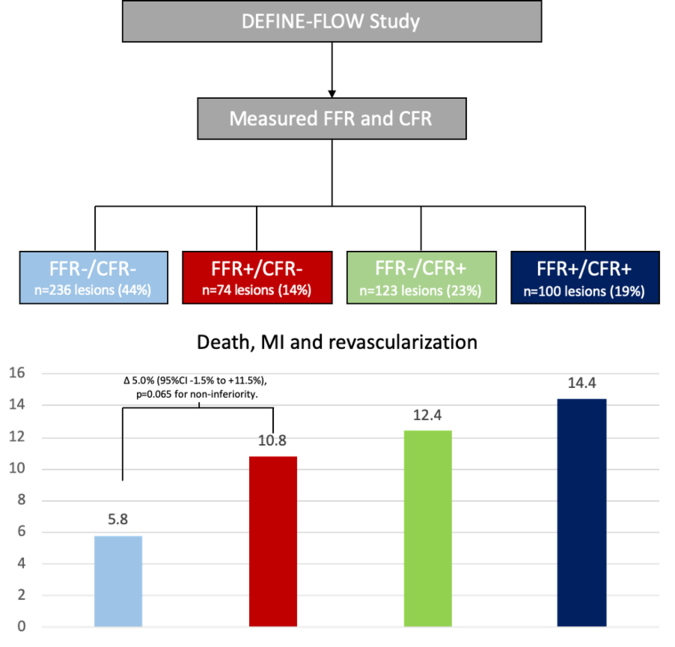The DEFINE-FLOW study combined CFR and FFR assessment
Reported from the TCT Congress 2020
At TCT Connect 2020, Nils Johnson presented the results of the DEFINE-FLOW study. Carlos Collet provides a summary of the key messages.
Coronary artery disease can be invasively assessed by means fractional flow reserve (FFR) or coronary flow reserve (CFR). FFR is a ratio of coronary and aortic pressures characterizing epicardial conductance. In the other hand, CFR assesses both the epicardial and microvascular compartments and is defined as the ratio between hyperemic and resting flows. Low FFR has been associated with an increased incidence of adverse cardiovascular events. Similarly, patients with low CFR have a worse prognosis compared to patients with high CFR. A significant proportion of patients have discordant FFR and CFR results. In other words, patients with epicardial hemodynamically significant lesions (FFR ≤0.80) may have preserved coronary flow assessed by CFR. DEFINE-FLOW aimed to answer the clinical question of whether patients with low FFR but high CFR have non-inferior outcomes compared to patients with both high FFR and high CFR when medically treated.
DEFINE-FLOW was a multicenter prospective study including 430 patients with 533 lesions. In patients with an FFR ≤0.80 the criterion to perform PCI was based CFR <2. In other words, patients with an FFR ≤0.80 but CFR ≥2.0 were medically treated whereas patients with low FFR and CRF underwent PCI. CFR was measured using Doppler flow velocity wire (Combowire, Philips/Volcano). The primary end-point was non-inferiority between FFR+/CFR- and FFR-/CFR- in terms of death, myocardial infarction and any revascularization at two years. The non-inferiority margin was set at 10%.
Low FFR and low CFR observed in 33% and 42% of lesions
Overall, low FFR and low CFR were observed in 33% and 42% of the lesions, respectively. 44% were FFR-/CFR- whereas 14% were FFR+/CFR-. As expected, patients with FFR-/CFR- had low event rates (5.8%) whereas patients with FFR+/CFR- had higher rates of adverse events (10.5%). The difference in event rates was 5.0% (95%CI -1.5% to +11.5%, p-value 0.065 for non-inferiority. Thus, the natural history of lesions with an FFR+/CFR- is NOT non-inferior to lesions with FFR-/CFR-. In other words, deferring PCI in hemodynamically significant lesions based on FFR but with high CFR was associated with a higher than anticipated difference in events compared to lesions with high FFR and high CFR. Moreover, in the time-to-failure Cox model FFR but not CFR was an independent predictor of adverse events.
A hypotheses-generating study
DEFINE-FLOW emphasizes the importance of epicardial pressure gradients on clinical outcomes. Even in presence of high CFR, vessels with low FFR had higher event rates than ‘normal’ vessels. In these cases, higher flow rates will induce even larger pressure gradients increasing the risk of plaque destabilization. In DEFINE-FLOW events were mainly driven by revascularization (32/39) and myocardial infarction (5/39). The unblinded design may have also influenced the performance of PCI/CABG. Thus, as concluded by the authors DEFINE-FLOW is a hypotheses-generating study.
There are many open questions concerning how to treat patients with abnormal microvascular function. In DEFINE-FLOW patients with FFR-/CFR+, pointing at the presence of predominant microvascular disease, had also numerically higher target vessel failure rates compared to FFR-/CFR- patients. For these patients, we are yet to find an effective treatment strategy.






No comments yet!